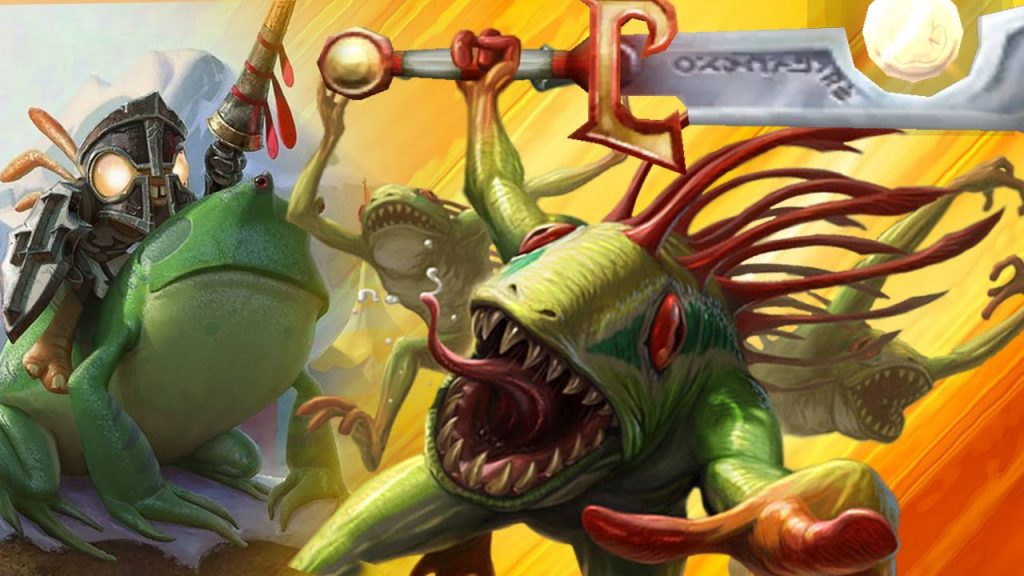For Hearthstone players of the world, the class identity of Paladin may have always been the most obvious of all classes: A holy warrior that fights for what is good, antagonizing all evil beings and their actions with utmost conviction. This very general description applies not only to Hearthstone’s class but the famous Paladin identity in modern fantasy story-telling as a whole which goes way back to medieval literature.
Blizzard picked this easy-to-understand, “black and white” character concept and put it into their games, starting with Warcraft II. Going forward, the Paladin class became an Alliance-exclusive playable character archetype in World of Warcraft and turned out to be one of the most popular class choices over the last 15 years of Blizzard’s MMO.
With the creation of Hearthstone, the core values of the Paladin fantasy couldn’t have been translated more clearly. However, over the course of the years of development, Paladin suffered several identity crises, and only just recently turned into a prime example of fantasy-driven card design thanks to Scholomance Academy and the Pure Paladin archetype.
In the second part of our Class Identities series, we dive deep into Paladin lore, the history of Paladin class design in Hearthstone up to this day, and possible future developments that would fit the Paladin identity.
The Past of Paladin
As already said, the original translation between Warcraft’s take on Paladin fantasy and the first look of the Paladin class after Hearthstone’s release just made sense. Besides Druid, Paladins in World of Warcraft are the only class that is able to fulfill all three “trinity” roles that modern-day MMOs offer: they can tank, deal and heal damage based on their specialization. In all of those roles they are also able to use the power of the Holy Light, the resource behind Azeroth’s “world religion”, to bless their allies in battle.
Looking at Paladin’s Basic and Classic set, the “jack-of-all-trades” fantasy is easily showcased through several core mechanics in card design: Healing and stat increases build synergy between cards, while an arsenal of weapons together with the Divine Shield mechanic enables Paladins to bestow the holy word upon their enemies in melee combat.
Sadly, the streamlined Paladin experience of becoming a blessed warrior who fights for the one sacred purpose has been washed away over the course of the years, and that only gets clearer once we have taken a closer look at the most influential Paladin archetypes in Hearthstone history.
First, and certainly most shockingly, there is Murloc Paladin. MURLOC Paladin. We have dug deep in the libraries of Warcraft lore, and after our zealous studies, one thing remains very certain: There is not a single reason why the Paladin class identity and the Murloc minion type would be a particularly great match.

To be honest, the decision to put together the warriors of the Holy Light and the non-intelligent life form most certainly derived from fantasy-independent design concepts like advertising some sort of “Zoo Paladin” playstyle. And while we all love Hearthstone’s silly approach to Warcraft lore, murlocs, in general, should stay the neutral tribe they still are in all other Warcraft universes.
Other tribe-related archetypes like Dragon or Mech Paladin can be put in the “murloc basket” of poor decisions regarding essential class fantasy that just water down the noble and stringent Paladin identity. Thankfully, Paladin’s top archetypes over the years did not only include tribe-heavy lists. Both Secret Paladin and Silver Hand Paladin showed true potential in terms of providing the archetypical “feel” of being a warrior of the light.
In terms of class design, the inclusion of secrets as a Paladin mechanic always felt somewhat arbitrary, but it does make sense lore-wise: Every cult-like group has secrets that only the believers should know, and every nonbeliever will be punished if they try to reveal those secrets. Another great lore approach is the Paladin secret as some sort of “divine intervention” in-between their own turns – a last-ditch effort either to convert their seemingly lost enemies or to save their wounded brethren.
Silver Hand Paladin, or “Dude” Paladin, relied on swarming the board with Silver Hand Recruits, which on their own showcased the structural hierarchy of Paladins in the world of Azeroth. The Order of the Knights of the Silver Hand was the first group of paladins in the Alliance, led by Tirion Fordring, to fight in the name of the Holy Light. And what else would be more paladin-like then to overwhelm the enemy with members of the most elite group of paladins that Warcraft lore has seen?
The Present of Paladin
Despite the earnest efforts of Paladin archetypes becoming more identity-related, lists like Murloc and Aggro Paladin put the class back into the state of using neutral card design more than anything. The first step away from this rollercoaster of finding Paladin’s identity was the inclusion of Librams with the Ashes of Outland expansion.
We don’t need to talk a whole lot about the obvious lore implications of Librams. Paladins use books as a source of information – and not only for the sake of historic accuracy, but also to learn about the holy magic of the Light that they intend to use on the battlefield. The full art of Uther Lightbringer, one of Azeroth’s most influential paladins, shows him holding a libram, and that should be enough evidence to see how important librams are to the Paladin class fantasy.
The introduced minions to support the released Librams fully immerse themselves in the way of the Paladin – Lightforged Zealot and Aldor Truthseeker showcase its core values through their names alone.

Together with Lightforged Crusader, a unique card design that single-handedly kickstarted the Pure Paladin archetype, the Libram package was destined to pair up with highly synergistic Paladin cards. However, it was Scholomance Academy’s card additions that gave Pure Paladin enough fuel to light up the zealous fire of a list that was highly competitive and purely relied on class cards.
For that, Pure Paladin once again relies on its core values and mechanics: Goody Two-Shields and Devout Pupil offer insane value in the spell-heavy deck, while cards like Blessing of Authority level up Pure Paladin’s buff-centric gameplay. This new and very strong Paladin core form a class-exclusive base that is even able to shelter isolated minion-type cards that don’t really fit the current theme like Shotbot or Murgur Murgurgle.
But in the end, it is the exclusivity of Pure Paladin that makes it a true and flavorful Paladin archetype. A Paladin fights for what is good and true – but those characteristics ultimately lie in the eye of the beholder, as we all know. Their strong belief leads the average paladin into thinking that they and only they can change the world.
Banishing all non-Paladin cards from this list feels so right – at least from a Paladin point of view, as this pure ignorance remains a negative yet important feat of the holy warriors that can’t see what lies beyond their belief. In the end, Pure Paladin uses clever class-exclusive card design that wonderfully ties in with how the majority of the world perceives a Paladin.
The Future of Paladin
We have to admit that, from a lore standpoint, Pure Paladin may rely on its fanatical side just a bit too much. However, future class design should definitely double-down on common Warcraft Paladin fantasy elements.
For example, one new gameplay element could rely on the usage of so-called Seals. In World of Warcraft, Paladins use seals to bolster their melee attacks. Seal of Champions as well as Seal of Light showed great potential, but many more seals could be turned into Hearthstone cards to make weapon usage more feasible.
Another great addition to the Paladin toolkit would be Aura spells. Auras are used in World of Warcraft to buff up allies in the Paladin’s vicinity for both defensive and offensive use. A minion-heavy archetype would welcome cards that have board-wide buff effects over multiple turns or dependent on board positioning.
Our third suggestion and a generally broad topic that could turn into a design route is death, resurrection, and conversion. Similar to priests, paladins worship the light and use it to resurrect their fallen allies and influence their enemies.

While the resurrect mechanic creates highly negative associations these days, its potential in terms of class identity is intriguing. Maybe temporary resurrection or even conversion similar to Shadow Madness and Cabal Shadow Priest could have a place in Paladin’s toolkit. After all, their highest priority is to convince their enemies of what they think is right even if they have to revive them to try all over again!
Thanks to its broad representation in Warcraft games and World of Warcraft, the identity of Paladins offers many different negative and positive characteristics that could be transported to the world of Hearthstone. Scholomance Academy’s Pure Paladin started a solid trend and could serve as a precedent for future design decisions revolving around the flavorful Paladin class identity.

Here’s a hint for the upcoming Shaman’s “class identity”:
Garbage.
Oh come on now – Totem Shaman isn’t that PFFFFT BwA HA HA! Boy – couldn’t keep a straight face on that one.
Maybe next set they will give us some Spell Damage cards that aren’t dogshit.
Coming from the general feel of Totem Shaman – do you feel like it’s THAT bad? We’re not talking about general strength of the archetype!
I don’t say that to be mean – I say that because I love Shaman. I just felt the class could use some focus when i made that comment – though it’s amazing how one card has changed everything with the last meta shift. I also really really want a deck that can use Ras Frostwhisper.
Aura Tech is definitely suit the paladin arsenal, even as far as old Diablo.
But an aura spell card may not be available, since it’s hard to define how the card works, (and somehow, other class may need a counter for this)
some kind of weapon with always-active skill may serve better, unlike Sword of Justice.
something like legendary weapon with “Battlecry: Give Silver Knight +1/+1 for this game”, just like Goru.
I think it can be a viable aura replacement. The more effect like that the better.
But otherwise, TBH, I never consider aura skill for Paladin until I read your article. Nice one.
Thanks! Fun fact: My first Diablo II character was an Aura Paladin!
Great read, I am enjoying these.
Thanks for reading!